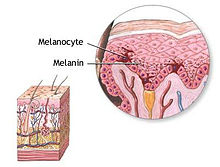Informatics Educational Institutions & Programs
Contents
| Piebaldism | |
|---|---|
| Other names | PBT[1] |
 | |
| This condition affects melanocyte development | |
| Specialty | Dermatology |
Piebaldism refers to the absence of mature melanin-forming cells (melanocytes) in certain areas of the skin and hair. It is a rare autosomal dominant disorder of melanocyte development.[2]: 867 Common characteristics include a congenital white forelock, scattered normal pigmented and hypopigmented macules and a triangular shaped depigmented patch on the forehead. There is nevertheless great variation in the degree and pattern of presentation, even within affected families. In some cases, piebaldism occurs together with severe developmental problems, as in Waardenburg syndrome and Hirschsprung's disease.
Piebaldism has been documented to occur in all races, and is found in nearly every species of mammal. The condition is very common in mice, rabbits, dogs, sheep, deer, cattle and horses—where selective breeding has increased the incidence of the mutation—but occurs among chimpanzees and other primates only as rarely as among humans. Piebaldism is unrelated to conditions such as vitiligo or poliosis.
Although "partial albinism" is a synonym for piebaldism,[3] it is a fundamentally different condition from true albinism. The vision problems associated with albinism are not usually present as eye pigmentation is normal. Piebaldism differs from albinism in that the affected cells maintain the ability to produce pigment but have that specific function turned off. In albinism the cells lack the ability to produce pigment altogether. Human piebaldism has been observed to be associated with a very wide range and varying degrees of endocrine disorders, and is occasionally found together with heterochromia of the irises, congenital deafness, or incomplete gastrointestinal tract development, possibly all with the common cause of premature cutting off of human fetal growth hormone during gestation. Piebaldism is a kind of neurocristopathy, involving defects of various neural crest cell lineages that include melanocytes, but also involving many other tissues derived from the neural crest. Oncogenic factors, including mistranscription, are hypothesized to be related to the degree of phenotypic variation among affected individuals.
Genetics
Piebaldism is an autosomal dominant[4] hereditary condition, which tends to produce high rates of inheritance and long chains of generational transmission. All who inherit the gene have at some time in life evidence of piebald hypopigmentation of the hair or skin, most likely both.[citation needed]
Piebaldism may be associated with the genes KIT[5] or SNAI2.[6]
Diagnosis
Usually diagnosed at birth with the appearance of patches of white skin on the arms, legs, stomach, forehead, and a white lock of hair.
History
Early photographers took many photographs of African people with piebaldism as a form of entertainment and exoticism, and George Catlin is believed to have painted several portraits of Native Americans of the Mandan tribe who were affected by piebaldism.[7]
Historically, persons with extensive piebaldism have experienced abuse of the sort still suffered in the present by albinos, especially in Africa. This has ranged from display of unclothed African piebalds in "freak" shows and postcards of the early 20th century to the forcing of piebalds (as in the case of albinos) to work long hours exposed to the sun (producing high rates of lethal skin cancers), to the use of piebald humans, including children, in risky medical experiments. The National Organization of Albinism and Hypopigmentation, as well as organizations such as Under the Same Sun, work to promote awareness of all forms of cutaneous variation and their medical implications, and to highlight human rights issues, especially the plight of albinos subject to extreme persecution in parts of Africa.[8]
Etymology
The word "piebald" originates from a combination of "pie," from "magpie", and "bald", meaning "white patch" or spot.[9] The reference is to the distinctive black-and-white plumage of the magpie.[10]
See also
References
- ^ "Piebaldism | Genetic and Rare Diseases Information Center (GARD) – an NCATS Program". rarediseases.info.nih.gov. Archived from the original on 16 April 2019. Retrieved 16 April 2019.
- ^ James, William; Berger, Timothy; Elston, Dirk (2005). Andrews' Diseases of the Skin: Clinical Dermatology. (10th ed.). Saunders. ISBN 0-7216-2921-0.
- ^ "Partial Albinism". Retrieved Jan 1, 2024.
- ^ MedlinePlus Encyclopedia: Autosomal dominant
- ^ Giebel, L. B.; Spritz, R. A. (1991). "Mutation of the KIT (mast/stem cell growth factor receptor) protooncogene in human piebaldism". Proceedings of the National Academy of Sciences. 88 (19): 8696–9. Bibcode:1991PNAS...88.8696G. doi:10.1073/pnas.88.19.8696. JSTOR 2358007. PMC 52576. PMID 1717985.
- ^ Sánchez-Martín M, Pérez-Losada J, Rodríguez-García A, et al. (October 2003). "Deletion of the SLUG (SNAI2) gene results in human piebaldism". Am. J. Med. Genet. A. 122A (2): 125–32. doi:10.1002/ajmg.a.20345. PMID 12955764. S2CID 33811699.
- ^ Victor A. McKusick, Mendelian Inheritance in Man: A Catalog of Human Genes and Genetic Disorders, Volume 1 (Johns Hopkins University Press, 1428-1429)
- ^ Spritz, RA (1997). "Piebaldism, Waardenburg syndrome, and related disorders of melanocyte development". Seminars in Cutaneous Medicine and Surgery. 16 (1): 15–23. doi:10.1016/s1085-5629(97)80031-4. PMID 9125761.
- ^ Harper, Douglas. "Piebald". Online Etymology Dictionary.
- ^ Skeat, Walter W. (1882). The Concise Dictionary of English Etymology. Hertfordshire: Clarendon Press. p. 442.

















